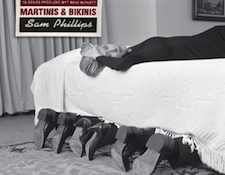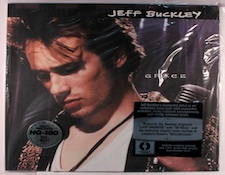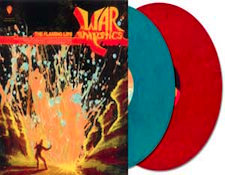It’s the time of year for saving money!

As an audio fan in these digital days, it sometimes is a wonder to realize that some albums didn’t originally — or ever — come out on vinyl, but CD. More recently, some have come out only as a download. Thus for the music to make an impression on us, the songs have to be pretty amazing. Here are some albums that have appeared on vinyl recently, all of which made their impression pretty much first in digital domain before getting the analogue treatment
Martinis and Bikinis, Sam Philips – From the opening beats of ‘Signposts,” second song on Sam Phillips modern day rock pop classic Martinis and Bikinis (from 1994), it is very apparent what a difference an LP makes — the kick drum beats at the beginning of the song are like a sucker punch to the gut in a dark alleyway and when the bass kicks in you feel the true reggae roots of this great album opener. On the CD, the kick drum sounds like someone tapping politely on your shoulder to move aside in the aisles at a shopping market. Details like this abound.
The huge studio ring of the drums on “Same Rain” make this album sound timeless, while on the CD the snap of the snare has been reduced to an echo of all the gated drum sounds from the 80s. This album has so many great songs, if it wasn’t for Sam being a woman, you might even think this was some sort of lost Beatles album. Really, it has that vibe. That notion wasn’t lost on Sam who included a haunting cover of John Lennon’s “Gimme Some Truth.” This is one of those albums that producer T-Bone Burnett perfected his sound on, employing many studio greats including Jerry Scheff (of Elvis’s Presley and Costello fame), Colin Moulding (XTC), Peter Buck (REM), Van Dyke Parks (Brian Wilson’s SMiLE), Benmont Tench (Tom Petty) and Marc Ribot (Tom Waits).
The vinyl on this new limited edition white vinyl pressing from Omnivore is generally very good, with a nice thick platter that is well centered and discs that are not warped. There was bit of surface noise at the start of one side but that may have been some static due to my Zerostat being at the repair shop. Anyhow, this is a gem so if you love the album on CD, you will adore it on LP.
Some Others You May Have Missed on Vinyl

Grace, Jeff Buckley — This one snuck out a few years back on sweet 180-gram vinyl, pressed at RTI, and it sounds huge. Again, if you know the CD, you’ll find the LP remarkable. If you don’t know about Grace, use the Interwebs and read up on it — so much has been written about Jeff and his amazing (and sadly short) journey. It may be the best $20 you’ll spend this year.

At War With The Mystics, The Flaming Lips – This fabulous follow up to the band’s amazing Yoshimi Battles The Pink Robots expands on that flavor and yielded not only one of their biggest hits (“The Yeah Yeah Yeah Song”) but also a two-LP length song cycle that builds an emotional mood this side of Pink Floyd’s Wish You Were Here. The album has been released on 180-gram black vinyl as well as really cool colored vinyl that beautifully matches some of the central color themes of the album artwork. I went for the latter and have not been disappointed. Interestingly, and I am guessing here, but in comparing to the CD and the DVD-Audio Disc, it sounds like a different mix on LP as certain instruments are more striking (particularly the acoustic guitars). If you don’t know The Flaming Lips music, this might be a good place to start. Or pick up The Soft Bulletin or Yoshimi (now also on vinyl). Its on sale at Oldies.com for $20!







Ever read up on – or even better experience – the actual process of how LPs are made? Mastering for LP requires all kinds of compromises in sound from the original master recording:
http://www.recordingmag.com/resources/resourceDetail/113.html
The above article describes the mastering process from the perspective of the engineers who actually do the work. While one might prefer the sound of LP to CD, we should not be under any illusions that it reflects a more accurate reproduction of the original master recording. Mastering an LP requires adding all kinds of distortions to the original signal in order for the record to play back properly. Now, if one likes the sound of those distortions, more power to them. However, that does not change the fact that they are still distortions.
Thanks for the link to the Recording Mag article. I have a lot of vinyl in my collections (most of it 40-60 years old) but I’ve never been intimate with the process before and appreciate the insight. I think the future of digital audio is going to be with higher resolution formats and recording processes. It will not be long before 128 bit cpu’s are introduced, and with high quality solid state drives as target media the potential for awesome sonic quality is very high.
128-bit makes sense for production but the finished product doesn’t have to be that. Standard red book, according to double-blind tests is good enough. Mostly, the perceived difference is in the headpsychoacoustics.
Actually John, I have produced recordings for my own band and witnessed the mastering process several times, so yes I know about that. At the end of the day, all that matters is whether the recording sounds as good as it can. In many cases, the LP does trounce the CD — but not always, I admit, especially if the mastering or pressing was iffy on a particular LP and it has been cleaned up for a new era CD. In general, the compression used to crunch a recording down to 44.1/16 takes a lot of the heart and soul out of a recording and this becomes very apparent when comparing a CD to a version presented via a higher resolution medium — be it a hi res download, DVDA/SACD/Blu-ray or, audiophile grade LP. This inconsistency, while frustrating to some, also makes the hobby of collecting music that much more interesting because there is always the prospect of finding a better sounding version of a favorite recording around the corner. 🙂